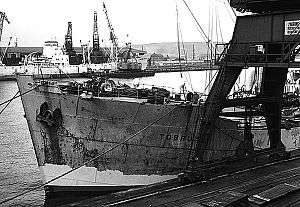SS Tobruk
Tobruk was a 7,090 GRT cargo ship which was built in 1941 as Empire Builder by William Gray & Sons Ltd for the Ministry of War Transport (MoWT). On completion she was handed over to the Polish government-in-exile and renamed Tobruk. She was a member of a number of convoys during the Second World War. She was sold in 1951 to Polskie Linie Oceaniczne and served until 1967. She was scrapped in 1968.
 SS Tobruk after the War | |
| History | |
|---|---|
| Name: |
|
| Owner: |
|
| Operator: |
|
| Port of registry: |
|
| Builder: | William Gray & Co Ltd |
| Yard number: | 1123 |
| Launched: | 19 November 1941 |
| Completed: | January 1942 |
| Out of service: | 1967 |
| Identification: | IMO Number 5616130 (-1968) |
| Fate: | Scrapped June 1968 |
| General characteristics | |
| Tonnage: | |
| Length: | 430 ft (131.06 m) |
| Beam: | 56 ft 2 in (17.12 m) |
| Depth: | 35 ft 2 in (10.72 m) |
| Propulsion: | 1 x triple expansion steam engine |
| Speed: | 9.5 knots (17.6 km/h) |
Description
Empire Builder was built by William Gray & Sons Ltd, West Hartlepool.[1] She was yard number 1123. Empire Builder was launched on 19 November 1941 and completed in January 1942.[2]
The ship was 430 feet (131.06 m) long, with a beam of 56 feet 2 inches (17.12 m) and a depth of 35 feet 2 inches (10.72 m). She was propelled by a triple expansion steam engine which had cylinders of 24 1⁄2 inches (62 cm), 42 inches (110 cm) and 70 inches (180 cm) bore by 48 inches (120 cm) stroke. The engine was built by Central Marine Engine Works, West Hartlepool.[3] It could propel her at 9.5 knots (17.6 km/h)[4] Empire Builder was listed on Lloyds Register as having a GRT of 7,090 and a NRT of 5,050.[3] Tobruk was listed on Lloyds Register as having a GRT of 7,048 and a NRT of 4,977.[5] Her DWT was 10,500.[4]
Career
Empire Builder's port of registry was West Hartlepool.[3] On completion, she was handed over to the Polish Government and renamed Tobruk.[1] Her port of registry was changed to Gdynia.[5] Tobruk was owned by the Polish government and operated under the management of Gdynia-America Shipping Lines Ltd.[6]
- PQ 13
Convoy PQ 13 departed Loch Ewe on 10 March 1942 and arrived at Murmansk, Soviet Union on 31 March having lost six ships to enemy action. A further two were sunk at Murmansk after the convoy's arrival.[7] Tobruk was damaged by enemy bombing at Murmansk, repairs took about six months to complete.[8] Crew members were joking later that the convoy departed on the 13th day of the month, the trip lasted 13 days, and Tobruk had the thirteenth position in the convoy.[9]
- QP 14
Convoy QP 14 departed Murmansk on 13 September 1942 and arrived at Loch Ewe on 26 September, having lost four ships to enemy action.[10] Tobruk was carrying a cargo of Apatite. She departed Murmansk on 8 September bound for Archangelsk, from where she joined the convoy.[8]
- SL 178
Convoy SL 178 departed Freetown, Sierra Leone on 25 November 1944 and arrived at Liverpool on 15 December. Tobruk was on a voyage from Pepel to Barry, Glamorgan. She was carrying a cargo of iron ore and two passengers.[11] On 9 December, a deceased seaman from Tobruk was buried at sea.[12]
Postwar, Tobruk continued in Polish Government service until 1951 when she was sold to Polskie Linie Oceaniczne.[1] In 1950 during a storm in the Bay of Biscay in order to prevent the ship from crashing into the local reefs the crew improvised a sail, saving the ship; this is the only known example of a modern bulk carrier using a sail.[13] She served until 1967,[4] and was scrapped at Gdynia in June 1968.[2]
In popular culture
The wartime history of the ship has been portrayed in a novel S.S. Tobruk – w konwojach śmierci (SS Tobruk – in the convoys of death) by Jana Kazimierza Sawickiego.[14]
References
- Mitchell, W H, and Sawyer, L A (1995). The Empire Ships. London, New York, Hamburg, Hong Kong: Lloyd's of London Press Ltd. ISBN 1-85044-275-4.
- "5616130". Miramar Ship Index. Retrieved 28 December 2009.
- "LLOYD'S REGISTER, STEAMERS & MOTORSHIPS" (PDF). Plimsoll Ship Data. Retrieved 29 December 2009.
- "Tobruk". Polish Ocean Lines. Retrieved 29 December 2009.
- "LLOYD'S REGISTER, NAVIRES A VAPEUR ET A MOTEURS" (PDF). Plimsoll Ship Data. Retrieved 29 December 2009.
- Dziennik Ustawy Rzeczypospolitej Polskiej Nr 3. Londyn. 24 marca 1942. http://eprints.hist.pl/135/1/1942-03-24_nr3.pdf
- "Convoy PQ 13". Warsailors. Retrieved 29 December 2009.
- "Report of Senior British Naval Officer (extracts) – September 1942". Halcyon-class. Retrieved 29 December 2009.
- Jan Piwowoński (1989). Flota spod Biało-Czerwonej. Nasza Księgarnia. p. 90. ISBN 978-83-10-08902-1. Retrieved 14 May 2012.
- "The Arctic Convoy's". Toys out of the Pram. Retrieved 29 December 2009.
- "Convoy SL.178 / MKS.69". Convoyweb. Retrieved 29 December 2009.
- The National Archives (UK), ref ADM 217/591 Retrieved 29 December 2009
- Jan Piwowoński (1989). Flota spod Biało-Czerwonej. Nasza Księgarnia. p. 92. ISBN 978-83-10-08902-1. Retrieved 14 May 2012.
- Jan Kazimierz Sawicki (1990). S/s "Tobruk" w konwojach śmierci. Graf. ISBN 978-83-85130-24-6. Retrieved 14 May 2012.